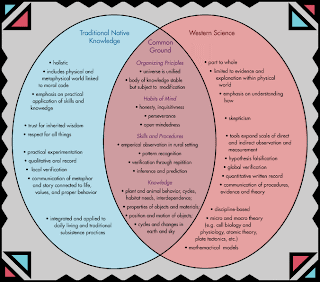How can digital resources and effective teaching methods be used to integrate Alaska Native ways of knowing and Western scientific methods in order to create greater understanding of, and interest in, geosciences for students?
Explore:
I am very excited about the knowledge that I have gained during this course along with the array of resources and ideas that I now have to help me create a new program at my school. I am going to be teaching a cultural leadership class with an emphasis on its importance in math and science. This posting will help me to begin planning how to make this class useful and successful to my students! The ideas below would not entail the entire leadership course, but would be weaved into the course throughout the semester.
The following are some questions that will be presented to my students, and through our research, discussions and presenters the students will be able to answer these questions.
What are scientific ways of knowing?
What are Native ways of knowing?
Can both these methods be used to gain knowledge? Why or why not?
What is the benefit of using both methods of knowing?
Engage:
Module 1:
What are scientific ways of knowing?
Many students will be more comfortable brainstorming these types of methods and the use of these methods for understanding science. I will use different scientific questions from the “6-8 Scientific Ways of Knowing” document to get students recognizing that many of our ways of knowing are things that we do naturally (making observations) and others are things that we are taught (deciphering a graph). The use of the TD Resource that shows students how all the parts of the scientific process are used will help show an accurate representation of how science is conducted.
Resources to use with students:
TD Video: Scientific Processes
6-8 Scientific Ways of Knowing
Professional Resources:
The Evidence Base for Science: Scientific Ways of Knowing
Module 2:
What are Native ways of knowing?
For some students this discussion will require more prompting because they have not been exposed to traditional ways of knowing or living and will be very foreign. Having students share their cultural knowledge gained from elders or community members with a discussion about why this knowledge is important will help access prior knowledge to better see the connection to western science. The TD lesson “Alaska Native Ways of Knowing” is a great resource to introduce how these traditional methods are important to cultures throughout our state. I will present students with examples of living an Alaska Native traditional lifestyle or a less traditional “city” lifestyle and how this knowledge is useful with the “Culturally-Based Curriculum Resources”.Resources to use with students:
Alaska Native Ways of Knowing
Culturally-Based Curriculum Resources
Professional Resources:
Indigenous Knowledge Systems/Alaska Native Ways of Knowing
Culturally-Based Curriculum Resources
Module 3:
Can both these methods be used to gain knowledge? Why or why not?
This module will emphasize the following Venn diagram.

We will discuss the “common ground” section of the diagram and what this means. It is important for students to understand that both traditional knowledge and scientific knowledge can stand alone but by combining these two ways of knowing we are strengthening our knowledge and supporting the certainty of that same knowledge. We are taking this knowledge beyond data and observations and are giving it depth and significance.
Resources to use with students:
TD Video: Steve MacLean: Conservationist
TD Video: An Alaska Native Community Helps Seals
Science and Culture
Professionl Resources:
Culture and Science Education: A Look from the Developing World
Science and Culture
Extend:
What is the benefit of using both methods of knowing?
The students will explore global warming and its effects at a local level by using both methods of knowing to support their research.
The students will create an essential question that will research the topic of global warming and it’s effects on a plant, animal or ecosystem and how this influences a specific Alaskan Native group’s subsistence lifestyle.
Resources to use with students:
TD Video: Alaska Native Teens Help Researchers
Professional Resources:
Lesson Plan Global Warming



